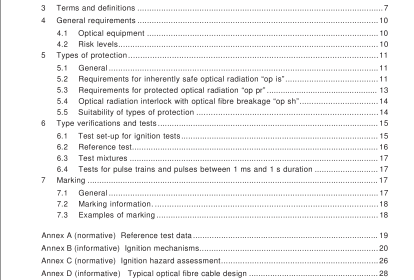BS EN 60079-28:2007 – Explosive atmospheres — Part 28: Protection of equipment and transmission systems using optical radiation

5 Types of protection 5.1 General Three types of protection can be applied to prevent ignitions by optical radiation in potentially explosive atmospheres. These types of protection encompass the entire optical system. These types of protection are
a) inherently safe optical radiation, type of protection “op is”;
b) protected optical radiation, type of protection “op pr”;
c) optical system with interlock, type of protection “op sh”.
5.2 Requirements for inherently safe optical radiation “op is” 5.2.1 General Inherently safe optical radiation means visible or infrared radiation that is incapable of supplying sufficient energy under normal or specified fault conditions to ignite a specific explosive atmosphere.
The concept is a beam strength limitation approach to safety. Ignition by an optically irradiated target absorber requires the least amount of energy, power, or irradiance of the identified ignition mechanisms in the visible and infrared spectrum. The inherently safe concept applies to unconfined radiation and does not require maintaining an absorber-free environment. NOTE Research to date [1 7-22] has concluded the following values of visible and infrared beam strength are safe for explosive gas atmospheres. The safe values incorporate a modest safety factor on observed ignition values obtained under severe test conditions. Ignition of a carbon disulfide-air mixture has been reported recently using 24 mW optical power.
5.2.2 Continuous wave radiation Optical powers or optical irradiance shall not exceed the values listed in Table 2, categorized by apparatus group and temperature class. The irradiance values are safe up to a maximum irradiated surface area of 400 mm 2 . For irradiated surface areas above 400 mm 2 , the temperature limits of the relevant temperature class apply. Table 2 contains information on combustible and on non-combustible absorbers. As an alternative to Table 2, for intermediate target surface areas where combustible solid targets can be excluded safe power values can be drawn from Figure 1 .
5.2.3 Pulsed radiation For optical pulse duration of less than 1 ms, the optical pulse energy shall not exceed the minimum spark ignition energy (MIE) of the respective explosive gas atmosphere. For optical pulse duration between 1 ms and 1 s, an optical pulse energy equal to 1 0 times the MIE of the explosive gas atmosphere shall not be exceeded. For optical pulse duration greater than 1 s, the peak power shall not exceed the safety levels for continuous wave radiation (see 5.2.2, Table 2). Such pulses are considered as continuous wave radiation.
For optical pulse trains, the single pulse criterion applies for each pulse. With repetition rates above 1 00 Hz, the average power shall not exceed the safety levels for continuous wave radiation. With repetition rates below 1 00 Hz, a higher average power may be applicable if demonstrated by tests according to Clause 6.
BS EN 60079-28:2007 – Explosive atmospheres — Part 28: Protection of equipment and transmission systems using optical radiation